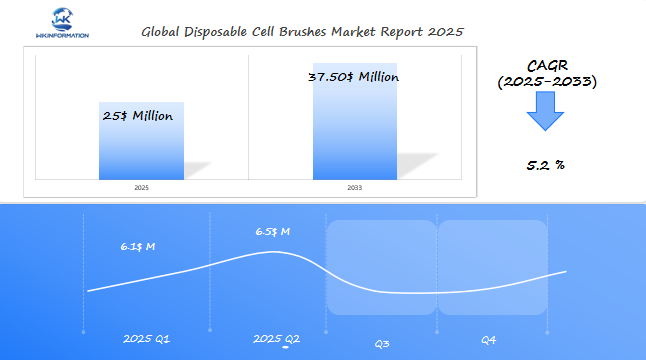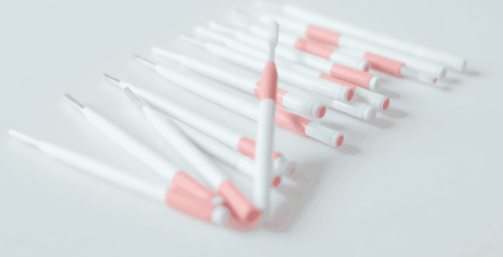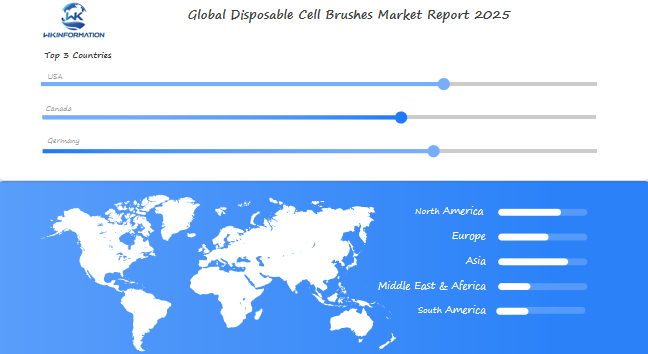2025 Disposable Cell Brushes Market Booming with $25 Million Potential in US, China, Germany
Explore the disposable cell brushes market in 2025, focusing on trends, U.S. manufacturing shifts, and key players like China and Germany.
- Last Updated:
Disposable Cell Brushes Market Forecast for Q1 and Q2 2025
The Disposable Cell Brushes market is projected to reach approximately USD 25 million in 2025, with a growth rate of 5.2% CAGR from 2025 to 2033. For Q1 2025, the market is expected to reach around USD 6.1 million, with Q2 2025 showing an increase to approximately USD 6.5 million. This growth is primarily driven by demand from the US, China, and Germany, where the healthcare and laboratory sectors continue to expand, fueling the need for high-quality cell brushes in medical and scientific research. The US is expected to lead the market, with China and Germany showing steady growth as they invest further in their healthcare and research infrastructures.

Understanding the Upstream and Downstream Industry Chain in the Disposable Cell Brushes Market
The industry chain of the Disposable Cell Brushes Market is a complex network that involves both upstream suppliers and downstream users.
Upstream Suppliers
Upstream suppliers play a crucial role by providing essential raw materials needed for manufacturing disposable cell brushes. These materials often include medical-grade plastics, adhesives, and fibers that ensure product safety and efficiency. The quality of these raw materials directly impacts the performance of the final product, making supplier partnerships critical for manufacturers aiming to maintain high standards.
Downstream Users
On the downstream side, key users like research laboratories and healthcare providers are pivotal in driving demand for these products. Laboratories depend on disposable cell brushes to collect samples without risking cross-contamination, while healthcare settings utilize them to uphold hygiene standards during medical procedures. These end-users require reliable, single-use brushes to comply with rigorous regulatory protocols, thereby influencing market demands and trends.
Understanding this industry chain provides valuable insights into how each segment interacts within the Disposable Cell Brushes Market, highlighting opportunities for innovation and partnership at various stages of production and distribution. This interconnectedness underscores the importance of maintaining strong relationships across all links in the chain to support market growth and development.
Key Market Trends Shaping the Future of Disposable Cell Brushes
The disposable cell brushes market is undergoing a significant change due to several key trends. One major factor driving this shift is the growing emphasis on sustainability in medical supplies, which has led to an increased demand for eco-friendly materials. In response, manufacturers are now prioritizing the use of biodegradable and recyclable components in their products. This not only helps them meet regulatory requirements but also appeals to environmentally conscious consumers.
1. Eco-friendly Materials
The adoption of sustainable raw materials is gaining traction, reducing the environmental impact of disposable cell brushes. This trend aligns with global efforts to minimize waste and promote green practices in healthcare settings.
2. Innovations in Materials Technology
Advancements in materials technology are improving the effectiveness and performance of disposable cell brushes. New composites and fibers are being developed, offering superior durability and precision, which are crucial for maintaining high hygiene standards during sample collection.
3. Integration of Smart Technologies
The incorporation of smart technologies into brush designs is setting a new standard for usability and efficiency. Features like integrated sensors that provide real-time feedback on sample collection effectiveness are being explored, potentially transforming routine laboratory procedures.
As these trends continue to evolve, they will likely redefine how disposable cell brushes are perceived and used across various medical and laboratory applications.
What’s Holding Back the Disposable Cell Brushes Market? Restrictions and Challenges
The Disposable Cell Brushes Market faces several market challenges that impede its growth. One of the primary obstacles is the regulatory hurdles that affect market expansion efforts. Stringent regulations in different regions require manufacturers to comply with various standards, which can be time-consuming and costly. This compliance process often delays product launches and hinders innovation within the industry.
Additionally, cross-contamination prevention during sample handling presents another significant challenge. Ensuring product safety and efficacy is critical, especially when disposable cell brushes are used in sensitive applications such as medical procedures and laboratory experiments. Manufacturers need to develop designs and production methods that minimize the risk of contamination, which requires additional research and development investments.
Addressing these challenges involves:
- Regulatory Adaptation: Companies must stay updated with global regulatory changes to swiftly adapt their products for different markets.
- Innovative Solutions for Contamination Control: Developing advanced materials and designs to enhance isolation capabilities during sample collection.
These factors are crucial in overcoming the restrictions faced by the Disposable Cell Brushes Market, paving the way for safer and more efficient products.

Geopolitical Tensions and Their Effect on the Disposable Cell Brushes Market
Geopolitical tensions can significantly disrupt the manufacturing and distribution channels for disposable cell brushes. These tensions often lead to trade restrictions, tariffs, and embargoes that complicate international logistics. As a result, manufacturers face challenges in sourcing raw materials and components from different countries, impacting production timelines and costs.
Impact on Global Supply Chain
The global supply chain for disposable cell brushes is vulnerable to disruptions caused by geopolitical issues. For instance, conflicts or diplomatic standoffs between countries can lead to delays in shipping, increased transportation costs, and even shortages of essential materials. Such disruptions necessitate strategic adjustments in supply chain management to ensure continuity of operations.
International Trade Dynamics
Geopolitical tensions alter international trade dynamics within this market segment. Countries embroiled in conflicts may introduce protectionist measures that limit exports or imports of medical supplies. This situation forces companies to diversify their supplier base and explore alternative markets for both sourcing and selling their products.
The ability to navigate these complex geopolitical landscapes is crucial for businesses aiming to maintain a competitive edge in the disposable cell brushes market. Understanding the implications of these tensions allows manufacturers and distributors to develop strategies that mitigate risks associated with global supply chain disruptions.
Exploring the Application Segments of the Disposable Cell Brushes Market
Disposable cell brushes play a vital role in several medical fields, primarily in dentistry and gynecology. These application segments underscore the importance of maintaining stringent hygiene standards and achieving precise sampling results.
Dentistry
In dentistry, disposable cell brushes are invaluable for collecting cellular samples from the oral cavity. Their design ensures minimal contamination risk, providing accurate diagnostic information. Dentists frequently rely on these tools for oral cancer screenings, where precision is critical to detect abnormalities early.
Gynecology
In gynecology, the use of disposable cell brushes is widespread. They are essential for cervical screenings, commonly known as Pap tests. The effectiveness of these brushes in collecting cells from the cervix is paramount for detecting pre-cancerous changes and ensuring women’s health.
Importance of Hygiene Standards
In both dentistry and gynecology, using disposable tools helps maintain high hygiene standards. Cross-contamination can lead to incorrect diagnoses or infections, making single-use brushes indispensable for safe practice.
These application areas highlight the indispensable role of disposable cell brushes in modern healthcare settings, ensuring accurate and reliable sample collection while upholding rigorous hygiene protocols.
Regional Growth Insights in the Global Disposable Cell Brushes Market
The Disposable Cell Brushes Market is experiencing different growth trends in various regions, offering valuable insights into regional growth.
North America holds a significant portion of the market with a 35% share. The region’s high healthcare standards and focus on advanced medical technologies drive this dominance. In places like the United States, ongoing investments in healthcare infrastructure and research facilities boost demand for disposable cell brushes.
Asia-Pacific, with a 30% market share, is quickly becoming an important player. Urbanization and the growth of healthcare sectors in countries such as China and India contribute to this expansion. The increasing emphasis on improving healthcare delivery systems and a rising number of research laboratories indicate potential for market growth in these areas.
Europe accounts for 25% of the market share, with countries like Germany leading advancements in medical technology. The European market benefits from strict hygiene regulations and strong research activities across various fields including dentistry and gynecology.
Identifying key growth areas within these regions reveals profitable opportunities for market players. Strategic geographical expansions and partnerships can take advantage of these regional trends, increasing the global reach and impact of disposable cell brushes.

US Disposable Cell Brushes Market Expansion and Competitive Landscape
The US market for disposable cell brushes is experiencing robust expansion, driven by the increasing adoption of minimally invasive diagnostic procedures and the growing emphasis on early disease detection. Healthcare providers are investing in advanced cytological tools that ensure high-quality cell sampling, which in turn is fueling demand for disposable cell brushes. The competitive landscape is marked by the presence of established players like CDx Diagnostics and Medgyn Products, alongside emerging innovators who are continually improving product quality and user-friendliness. Companies are differentiating themselves through investments in R&D, strategic partnerships, and comprehensive after-sales support, which strengthens their market positioning and drives overall growth.
China Disposable Cell Brushes Market Dynamics and Opportunities
In China, the disposable cell brushes market is characterized by dynamic growth and significant opportunities due to a rapidly evolving healthcare system and strong government initiatives. Local manufacturers, including industry leaders such as Bluesail Surgical and Changzhou Lookmed Medical Instrument, are leveraging cost-effective production methods and advanced manufacturing technologies to meet both domestic and international demands. The market dynamics are further enhanced by increased public awareness regarding preventive healthcare and the rising incidence of chronic diseases, prompting hospitals and diagnostic centers to upgrade their equipment. These favorable conditions offer ample opportunities for market expansion, product diversification, and enhanced export potential, setting the stage for sustained long-term growth.
Germany Disposable Cell Brushes Market Forecast and Investment Trends
Germany’s disposable cell brushes market is forecasted to grow steadily, propelled by the country’s advanced healthcare infrastructure and the high standards of medical diagnostics. The market benefits from strong investment trends in medical technology and diagnostics, as healthcare institutions continually seek innovative solutions to improve the accuracy of cell sampling and cytological examinations. Manufacturers in Germany are noted for their commitment to precision, quality control, and regulatory compliance, which reinforces consumer trust and drives market expansion. Investment trends indicate a focus on automation, digital integration, and next-generation diagnostic tools, which are expected to not only sustain but also accelerate market growth in the coming years.
Where Is the Disposable Cell Brushes Market Headed? Future Growth Insights
The future of the Disposable Cell Brushes Market is expected to change significantly due to upcoming trends and changing consumer preferences.
Projected Trends
As healthcare practices evolve, the demand for disposable cell brushes is anticipated to grow, influenced by technological advancements and increased focus on precision and hygiene in medical procedures. The integration of smart technologies could revolutionize brush functionalities, enhancing usability and efficiency.
Consumer Preferences
A noticeable trend is the shift towards sustainable products. Eco-friendly materials are becoming more prominent in manufacturing processes as sustainability gains traction within medical supplies. This change reflects a broader commitment to environmental responsibility while maintaining product efficacy.
These factors suggest a market trajectory that favors innovation and eco-conscious solutions, aligning with global sustainability goals. The market predictions indicate a robust growth path, driven by these evolving dynamics and consumer expectations.
Competitive Rivalry in the Disposable Cell Brushes Market: Key Players and Strategies
-
Bluesail Surgical – China
-
Aptaca S.p.A. – Italy
-
Olympus Corporation – Japan
-
CDx Diagnostics – United States
-
Medgyn Products, Inc. – United States
-
Laboratoire CCD – France
-
EDM Imaging – (Country not explicitly known; may require further verification)
-
Famed Żywiec Sp. z o.o. – Poland
-
Micro-Tech (Nanjing) Co., Ltd. – China
-
Changzhou Lookmed Medical Instrument Co., Ltd. – China
Overall
| Report Metric | Details |
|---|---|
| Report Name | Global Disposable Cell Brushes Market Report |
| Base Year | 2024 |
| Segment by Type |
·Straight |
| Segment by Application |
·Dentistry |
| Geographies Covered | · North America (United States, Canada)
· Europe (Germany, France, UK, Italy, Russia) · Asia-Pacific (China, Japan, South Korea, Taiwan) · Southeast Asia (India) · Latin America (Mexico, Brazil) |
| Forecast units | USD million in value |
| Report coverage | Revenue and volume forecast, company share, competitive landscape, growth factors and trends |
The Disposable Cell Brushes Market has great potential for growth, mainly due to the increasing demand for disposable medical and laboratory supplies. It is estimated that the market value will reach $25 million by 2025, with promising opportunities in countries such as the US, China, and Germany. Additionally, the adoption of sustainable practices and smart technologies is expected to redefine product offerings and improve user experience.
For a detailed analysis, you can refer to the Wkinformation Research report, which provides a comprehensive overview of the trends, challenges, and opportunities shaping this dynamic industry. This report can offer valuable insights for stakeholders looking to take advantage of emerging market developments.
To stay updated on the evolving landscape of the disposable cell brushes market, we encourage you to explore the complete research report.
Global Disposable Cell Brushes Market Report (Can Read by Free sample) – Table of Contents
Chapter 1: Disposable Cell Brushes Market Analysis Overview
- Competitive Forces Analysis (Porter’s Five Forces)
- Strategic Growth Assessment (Ansoff Matrix)
- Industry Value Chain Insights
- Regional Trends and Key Market Drivers
- Disposable Cell BrushesMarket Segmentation Overview
Chapter 2: Competitive Landscape
- Global Disposable Cell Brushesplayers and Regional Insights
- Key Players and Market Share Analysis
- Sales Trends of Leading Companies
- Year-on-Year Performance Insights
- Competitive Strategies and Market Positioning
- Key Differentiators and Strategic Moves
Chapter 3: Disposable Cell Brushes Market Segmentation Analysis
- Key Data and Visual Insights
- Trends, Growth Rates, and Drivers
- Segment Dynamics and Insights
- Detailed Market Analysis by Segment
Chapter 4: Regional Market Performance
- Consumer Trends by Region
- Historical Data and Growth Forecasts
- Regional Growth Factors
- Economic, Demographic, and Technological Impacts
- Challenges and Opportunities in Key Regions
- Regional Trends and Market Shifts
- Key Cities and High-Demand Areas
Chapter 5: Disposable Cell Brushes Emerging and Untapped Markets
- Growth Potential in Secondary Regions
- Trends, Challenges, and Opportunities
Chapter 6: Product and Application Segmentation
- Product Types and Innovation Trends
- Application-Based Market Insights
Chapter 7: Disposable Cell Brushes Consumer Insights
- Demographics and Buying Behaviors
- Target Audience Profiles
Chapter 8: Key Findings and Recommendations
- Summary ofDisposable Cell Brushes Market Insights
- Actionable Recommendations for Stakeholders

Access the study in MULTIPLEFORMATS
Didn’t find what you’re looking for?
TALK TO OUR ANALYST TEAM
Need something within your budget?
NO WORRIES! WE GOT YOU COVERED!
Call us on: +1-866-739-3133
Email: infor@wkinformation.com
What is the projected market size of the Disposable Cell Brushes Market by 2025?
The Disposable Cell Brushes Market is projected to reach $25 Million by 2025, with significant growth opportunities anticipated in the US, China, and Germany.
Who are the key upstream suppliers in the Disposable Cell Brushes Market?
Upstream suppliers in the Disposable Cell Brushes Market provide essential raw materials necessary for manufacturing disposable brushes, playing a vital role in the supply chain.
What are the major trends influencing the Disposable Cell Brushes Market?
Key trends shaping the Disposable Cell Brushes Market include increasing demand for eco-friendly materials, innovations in materials technology, and the integration of smart technologies into product designs.
What challenges does the Disposable Cell Brushes Market currently face?
The market faces regulatory hurdles that hinder expansion efforts and challenges related to cross-contamination prevention during sample handling, which are critical for ensuring product safety and efficacy.
How do geopolitical tensions impact the Disposable Cell Brushes Market?
Ongoing geopolitical tensions can disrupt manufacturing and distribution channels for disposable cell brushes, affecting international trade dynamics within this market segment.
What are some key application areas for Disposable Cell Brushes?
Disposable cell brushes are widely utilized in various application segments such as dentistry and gynecology, where they play a crucial role in maintaining hygiene standards and ensuring precise sampling results.


